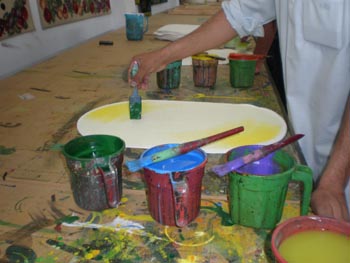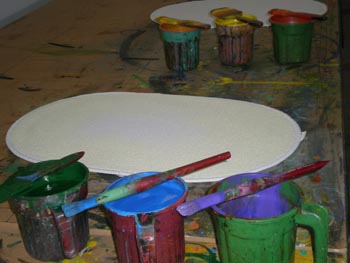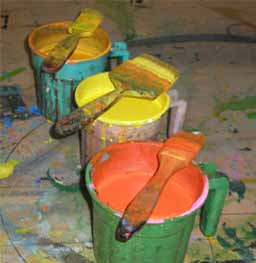The word calligraphy literally means beautiful writing. Before the invention of the printing press some 500 years ago, it was the way books were made, each copy being written out by hand by a scribe in a scriptorium on materials like vellum or parchment with a quill in one of the period bookhands like rustic, carolingian, blackletter, etc.
   |
This definition of calligraphy conjures up images of Mediaeval Manuscripts, fancy wedding invitations or some other beautiful quaint relic of a long ago time and is limiting to the potential it has to offer to the artist today. To the serious modern day practitioner, re-creating the past is not of much interest and I suspect a bore to the viewer as well. The question is "what is timeless, enduring & relevant about writing and drawing letters today? " More simply put, why do it?
Vehicles for communication or subject matter / medium?
Many believe the allure and relevance of writing letterforms by hand has something to do with craftsmanship (the satisfaction one receives from making things by hand...well ) and their expression potential.(drawing, writing and painting). Through the fluid line, the expressive brush- stroke, the graphic possibilities inherent in different alphabet structures and inventions, -the artist has a huge but related vocabulary in which to draw from, yet mutable enough to offer creative freedom. Spontaneously, one can connect heart, head and hand with a rich tradition while also exploring individuality . To calligraphers and letterform designers in general ,the alphabet could be compared to a musical tonal scale, the notes used by a musician or composer to compose songs. Some simple, some complex.
Another fertile source for creativity are the words, the possibilities that calligraphy offers in terms of marrying content and image. Used in the making of something useful, or as a leaping off point for more creative or abstract expressions, calligraphys' relevance lies in the human need for expression, through mark making, symbols, designing, drawing, painting, & crafting.
Timeless attributes are still relevant...
In the digital age the humanistic touch of the expressive hand are still very much sought after as evidenced by the number of digital typefaces that seek to emulate the characteristics of hand wrought letterforms, their cursive aspects as well as stylistic details of antiquity. Digital type can only imitate what comes naturally to the hand (unless we are talking about type design that is decidedly designed without references to the past and aims toward a criteria born out of requirements of legibility and esthetic criteria uniquely digital (or other medium). Unfortunately much type design today is merely pillaging the past. I think in contrast, there will be an increased longing for authenticity as the digital stuff becomes common place or "un-special" as I like to call it.
Object or image:
Besides the images one can create, calligraphy encompasses or is influential to other relevant topics: bookdesign, manuscript books, bookbinding, typeface design, logo design, sign making, handwriting, calligraphy as illustration, calligraphy as artistic expression. In many instances creating an image or making an object, the form / function relationship is an overlapping, subtle blend.
Image-making / object making: calligraphy is not a cookie cutter proposition. One does not just perfect a technique or an alphabet and repeat it over and over. At the highest level it is a dialogue with paper, ink and tool. A dance or performance. A rehearsed but spontaneous drawing subject to change by impulse, desire or whim. Somehow the accomplished scribe is able to imbue a familiar set of symbols with his her own mark uniquely filtered through in response to the need to express something about and within the medium of letters.
History is a foundation. Classical music is related to rock and roll, but not directly. To make that connection one has to know something of the history of music and see them both in perspective or the larger context. I'm personally not so interested in identifying separate things and saying look at the difference, I'm interested in the relationship, while maintaining individually. Although ancient scribes first concern was probably not individual expression, never the less they share some of the expressive attributes with their modern day counterparts. We just re-prioritize. The main difference is one of intent. To judge one by a set of criteria from the other is to overlook the merits each have to offer. Name and form is a problem in that we make judgements believing that categorizing is the same as really seeing or knowing.
Calligraphy has a long history and is probably considered by those on the bleeding edge to be old fashioned. I take the view that no matter what the medium, it is always satisfying when an artist / craftsperson is able to create / combine, make fine distinctions, show freedom within restraint, and share the sense of aethetics that is uniquely their own but speaks to the same place inside us all . What we recognize, we are.